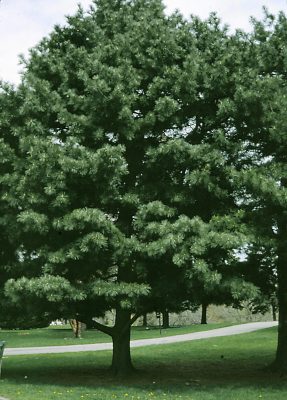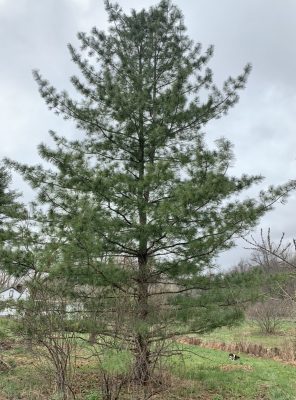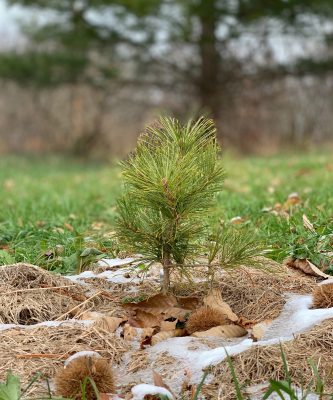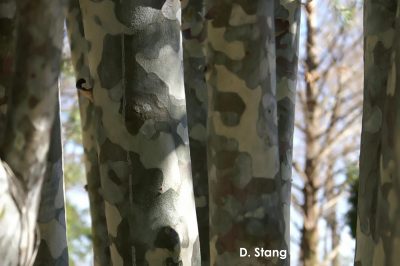PINING FOR PINES
More Than Just Pignolis and Piñons
Pine trees first appeared on earth 170 million years ago amidst lush, steaming forests of tree ferns and the footprints of dinosaurs. In time, human footsteps replaced those of the dinosaurs. Pines and humans have been intimately associated ever since. The trees have been worshipped; the cones have represented symbols of fertility; the pitch has sealed ship hulls; and the wood has been used for construction and for paper.
Korean pine
Throughout this long association, seeds of certain pines have been part of our diets. The flavorful seeds of native pines have a long history of use as “nutmeat” by the people of Siberia, the Himalayas, southern Europe, and the American Southwest. Look into almost any Italian grocery store in America, and you’ll find tempting cookies studded with pignolis, which are seeds of the Italian Stone pine (Pinus pinea). Pine nuts are the nut for pesto and dolmas. And from the American Southwest come seeds of the piñon pine.
Although pine nuts usually are associated with the dry, mild climates of Southern Europe, the American Southwest, and northern Mexico, there are pine species that will produce edible nuts outside of their native range — even in the humid, often frigid, climate of my farmden. Nut-producing pines run the gamut from scrubby shrubs to majestic trees, some with needles that are soft and misty, others with needles that are dark and somber.
Korean pine (P. koraensis), Swiss Stone pine (P. cembra), and Siberian pine (P. sibirico) are the three most reliable nut-producers for cold climates. All are hardy to at least minus twenty-five degrees Fahrenheit. The Korean pine is the most commercial of the three, producing 5/8-inch-long seeds that are exported from China. The tree itself will eventually tower to a soft, dark-green pyramid of 150 feet.
Swiss Stone pine finds a congenial home in the small garden, eventually reaching 50 feet or more, but very slow-growing. Native to central European Alps, this pine has dark, almost blackish-green, needles that, with the short branches, seem to hug the trunk. The Siberian pine is similar, except faster growing.
Swiss Stone Pine
Many other pine species potentially could produce pine nuts outside their native range, though their adaptability to very cold winter climates has not been not thoroughly tested. The closely related Colorado Pinyon (P. edulis) and Singleleaf Pinyon (P. monophylla) pines are bushy trees that become flat-topped with age. I planted a Singleleaf pine years ago; it’s annual growth was measured in inches. With the slow growth and lack of nuts, I eventually tired of it.
One of my favorites, unfortunately not hardy below 10°F, is the Digger (P. sabiniana). I saw many of these trees years ago as I was driving west down from the Sierra Nevada mountains; I came screeching to a stop when I spotted one of the large cones lying near the road. Passing motorists might have taken me for a lunatic as I tried to smash open the coneby smashing it repeatedly on the guardrail. This species bears lima bean sized pine nuts.
Some other pine species producing edible, albeit small seeds, are Himalayan pine (P. wallachiana), Limber pine (P. flexilis), Jeffrey’s pine (P. jeffreyi), and Japanese Dwarf Stone pine (P. pumila).
My Personal Pinetum
I’ve entered the world of nut pines with some plants here on the farmden. I began, of course, with Korean pine, but can’t claim great success. My largest tree, now about 35 feet high, has occasionally produced a cone near its summit. Perhaps some squirrels got them; I didn’t. The tree is a dead ringer for our native white pine (Pinus strobus); the most direct way to differentiate the two would be from the Korean pines cones, which are about half the length (about 4 inches) of white pine’s cones.
My older Korean pine
Just this year I purchased two more Korean pine seedlings. They’re each only a few inches high now, and I hope they bear like a friend’s Korean pine, which was loaded with cones when a mere 6 feet in height.
My younger Korean pine
I’ve also planted a lacebark pine (P. bungeana). Besides offering pine nuts, the bark of this pine flakes off to yield pleasing patterns similar to that of sycamore. Neither nuts nor flaking bark here yet, though.
Lacebark pine
Care and Feeding
Nut pines, in common with most other pines, require little care. They are frugal plants, getting by with minimum water and fertility. They do require full sun and well-drained soil, though. Think of those dry, rocky slopes to which pines cling in the wild.
Two seasons are usually required for a female pine cone to produce ripe seeds. The cone is a primitive type of flower constructed of a tight cluster of either male or female reproductive cells at the bases of scales which spiral around a short axis. In the spring gusts of wind shake loose pollen from the male cones, which are catkin-like clusters located mostly at the tips of the trees’ lower branches. Yellow clouds of pollen waft upwards to the female cones, most of which are high in the trees. Fertilization, the actual union of the male and female reproductive cells, takes place during the spring following pollination, within the tightly closed, green female cone. Seeds ripen at the end of the second season.
How a pine disperses its ripe seeds can mean the difference between getting pine nuts into your pesto or losing them to foraging squirrels or in the needles beneath the trees. With some pines, ripe seeds drop from open cones that remain attached to the trees. Other pines will not open their cones to release their seeds except with the stimulus of heat or the blow of a hammer. Such a mechanism, making it possible to beat the squirrels to the bounty, exists for the Swiss stone pine and the Siberian pine. The Swiss Stone pine clings to its neat little seed packages until the third spring from flowering.
It’s almost impossible to suggest an expected yield of nuts from a single tree. The trees are rarely grown in plantations. Most nuts are harvested from more or less wild trees, rather than from trees growing under uniform orchard conditions. And even then, yields are variable and erratic.
Lack of precocity or erratic nut production shouldn’t be a deterrent to planting a nut-bearing pine. What these pines lack in instant gratification, they furnish in “piney” fragrance, longevity, and for the beauty and character they bring to a landscape.






